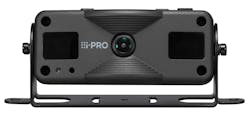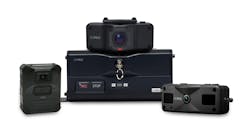Staying Alert: Human AI Detection Alarms Aiding Situation Awareness
What to know
- New rear and side cameras from i-PRO include Edge AI Human Detection and approach alerts to notify officers of approaching individuals, enhancing situational awareness.
- The technology supports improved video quality, low-light performance, and reduced distortion, aiding in investigations and evidence collection.
- In-car video systems provide critical context to body-worn cameras, capturing broader scenes and actions that are vital for accurate incident reconstruction.
More on OFFICER.com
Download the July/August issue of OFFICER Magazine.
Click Here to subscribe to OFFICER Magazine.
Standing outside a patrol vehicle on the side of a roadway is one of the most dangerous places for a law enforcement officer to find themselves. Oncoming vehicles pose a real risk, and one distracted driver can create a tragic outcome. Sitting inside a parked patrol vehicle can also prove to be a dangerous place for officers. Whether in a parking lot, alley or in front of a business or home, it can be difficult for officers to be aware of their surroundings in the event of an ambush attack.
New cameras released by i-PRO aim to change that by offering artificial intelligence human detection, along with human approach alerts. David O’Connor, Director of Public Safety Product Management at i-PRO Americas, recently spoke to OFFICER Magazine about the new side and rear-facing cameras and how technology is making officers safer in and around their patrol vehicles.
Advanced technology
The WV-VCR40W Rear/Side cameras were introduced to i-PRO’s Arbitrator ICV4000 in-car video system at the International Association of Chiefs of Police (IACP) annual conference last fall in Boston. The cameras are mounted inside the vehicle, similar to i-PRO’s past secondary cameras, but these new models include Edge AI Human Detection, along with added technology upgrades. The cameras use a 2.1MP 1/3” CMOS sensor supporting up to 1080p resolution and include a super wide-angle 150/180-degree field of view. It also features a configurable IR (Infrared) mode, along with an Auto mode that adapts to various lighting conditions.
“We heard from our customers about the importance of capturing that left, right and rear facing view. You don’t need it until you need it, and then when you need it, you want it to be very good,” says O’Connor about the addition of full-HD to the cameras. “The notion that, we’ll just get by with a much lower quality feed from those is no longer tenable.”
According to O’Connor, the AI revolution and AI at the Edge has caught up with many of the company’s products—primarily in the security industry—and coincided with the development of the new in-car auxiliary camera.
“The team just has a lot of expertise with object detection, boundary crossing and there are lots of algorithms that are in place in the security camera space,” he says. “The first one that they implemented was human detection, but we wanted intelligent motion detection. We want people, because dogs, vehicles, whatever—those are likely not going to be a threat to the officer. We wanted to be able to accurately identify that a human being is approaching the vehicle and give the officer that extra few seconds to assess the situation and make his or her own judgment.”
Giving officers control
As with any new technology, officers may be resistant or hesitant to adopt the new hardware and software thrust upon them. O’Connor stressed that obstacle was considered while developing the new cameras. “It was super important right from the get-go that we give the officer direct and very simple control. He or she has the ability to toggle the feature on and off,” he says. “It’s preconfigured to work in the background; it’s always ready. Just a simple one-button activation allows an officer to activate that human detection algorithm.”
He says the human detection alerts were not necessarily created for high traffic or parade environments and are instead intended for when officers need it the most. “This is more for those quiet times, admin times when they’ve backed into a place where they just need to finish a report and their focus is diverted from what they’re normally doing,” he says. “If it’s a scenario where (the alert) is going off frequently, what we don’t want is a nuisance response, where the officer is not going to use it because it keeps going off. We have a lot of investment in eliminating false or reducing false alerts.”
Hurdles to adoption
Following the IACP conference last October, the cameras were available to the market. As part of product transition, it will take time for departments to move their fleets over to the new cameras. “At IACP, the reaction was overwhelmingly positive,” says O’Connor. “There have been companies talking about human detection for five years or more, and we were able to demonstrate that all around the vehicle. That was powerful.”
Law enforcement agencies that have implemented the WV-VCR40W so far have reported improved video quality and the basic features of the new camera including the new lens, new senor, improved lowlight response, improved color and less distortion, according to O’Connor. When it comes to the AI Human Detection feature, there have been some early hurdles to adoption. “It’s just a handful of departments at this point who have played with it, and of course they have some policy decisions to make,” he says. “Anytime there is something new there are questions and guidelines that need to be created for the officers. Policy, guidelines, training, all those kinds of things are kind of catching up along with the technology.”
The importance of in-car video
With the advances to body-worn cameras over the years, the question can be made if dashboard-mounted in-car video systems are still useful. The i-PRO Arbitrator BWC4000 Body-Worn Camera, which has been part of the body camera revolution, has proved its worthiness to officers on the street, but O’Connor says that there is still very much a need for its in-car counterpart. “We have countless examples of the officer engaged in an encounter and yes, their body camera tells the story in a very intimate way of their direct interaction with that individual. What the vehicle then provides is that overall context,” he says “Whether it’s the body language of the officer or actions taken by the officer. Literally every time they step out of the squad, for them to be on camera in that larger frame contextual view. Did the passenger just jump out? Your body camera is only going to have a very limited perspective on that. What was the perceived threat by the officer and is that validated by what was going on around them in a larger field of view? Unfortunately, it’s in some of the worst instances where that contextual view is absolutely invaluable for investigation, future prosecution and taking action.”
He says that in standard activities, like field sobriety testing, body cameras can help assess how the individual is acting, but that the dashboard camera provides that greater context. “When you see a field sobriety test from the point of view of a dash camera, you get to see if that person is tracking the line or not tracking the line and if the officer followed all the correct procedures. It’s a lot less distracting, more focused and more structured. I think it’s still extremely valuable.”
How does the WV-VCR40W Rear/Side camera enhance the Arbitrator ICV4000 in-car video system in-car video system?
- The WV-VCR40W is i-PRO’s new Full HD / AI camera equipped with an upgraded sensor, lens, and enhanced video processing. This new camera offers significant improvements in image clarity and performance over previous camera models.
- Configurable InfraRed (IR) functionality supports flexible installation and deployment of up to 4 cameras (Backseat, Rear, Left, Right) across various vehicle types.
- Left and right-facing cameras are a valuable asset for enforcing distracted driving laws.
- With AI Human Detection, the ICV4000 / WV-VCR40W camera system gains an additional layer of officer safety and workflow automation, particularly during transport video recording scenarios.
How does the In-Vehicle Human Detection feature work?
- The system allows the user to define specific detection zones while masking areas that should be excluded.
- Within these zones, it detects human presence and movement up to 50–70 feet away from the vehicle, depending on lighting and environmental conditions.
- It filters out non-human objects or motion to reduce false alerts. This technology leverages the same AI engine used in i-PRO’s fixed security cameras.
- When a human is detected, the system immediately communicates the detection status to the Arbitrator Front-End (FE) application on the officer’s MDT.
- The FE acts as the user interface for the ICV4000, providing a simple on-screen toggle to activate or deactivate the Human Detection feature. The same control is used to clear an alert and return to active mode if desired.
- The ICV4000 can be configured to automatically begin recording and notify the officer when a human is detected in view. This provides the officer with critical additional time to assess the situation directly and respond appropriately.
How does the Human Approach Alert feature work?
- Up to four in-car cameras—Rear Seat, Rear Exterior, Left, and Right, can be individually configured to enable Human Detection and Alerting.
- The system supports two modes: simple alerting or alerting combined with automatic video recording.
- When human motion is detected, the corresponding camera view is automatically prioritized and brought to the forefront with live video displayed on the MDT.
- A red box outlines the camera feed to indicate detection, while a flashing red box signifies that automatic recording is in progress.
- Recording status is also confirmed through multiple visual indicators, including LEDs on the front camera, the VPU4000 unit, and other areas of the MDT interface.
- In addition to visual alerts, an audio notification, either a default tone or a custom WAV file provided by the agency can be played through the MDT speakers.
- Officers can easily acknowledge the alert and respond as necessary or re-enable the detection feature with a simple action.
How do these extra cameras and the addition AI alerts help improve situational awareness for officers on patrol?
- Officers often balance administrative tasks and report writing while inside their vehicles, which can limit their ability to stay fully alert to their surroundings.
- Even when parked in low-traffic areas, unexpected encounters can still occur. The WV-VCR40W supports officers by delivering continuous, intelligent monitoring of their surroundings.
- When a person approaches the vehicle, the built-in AI system generates real-time alerts, allowing officers to remain aware of potential threats and respond swiftly and appropriately.
About the Author
Paul Peluso
Editor
Paul Peluso is the Managing Editor of OFFICER Magazine and has been with the Officer Media Group since 2006. He began as an Associate Editor, writing and editing content for Officer.com. Previously, Paul worked as a reporter for several newspapers in the suburbs of Baltimore, MD.



